 | |
|  |
|
|
view titles only (low bandwidth) |
| |
| Skylab the mighty | Jul 30, 2011 4:31 AM PDT | url |
| | |
Added 1 new A* page:Well I've been talking about discoveries made by Skylab in recent posts, but I've never actually dedicated a post to Skylab itself (ie a post in which I summarize Wikipedia's Skylab entry for myself :p), so maybe it's due!
Oh first though I have to remind you, fair reader, about my weekend fairy tale comic, The Princess and the Giant, which updates Sundays, this weekend being no exception. So look forward to a new page of that, and if you need catching up, here's a link/preview to/of last week's page:

~~~~~~~~
Okay, Skylab!

image by NASA (source)
After the Apollo program succeeded in landing men on the Moon in the late 60's, NASA knew they'd have to find something else to do with the people and hardware that had been put to work in Apollo. One thing they came up with was using the workhorses of the Apollo program, the mighty Saturn V rockets, as carriers of space station components that would be designed to fit neatly into the shell of one of the rocket's sections; this type of scheme actually went back to ideas that German scientist and "father of American space flight" and all that, Wernher von Braun, had submitted as far back as 1959. A station based on this type of scheme was developed, and the result, Skylab, launched into Earth orbit on a modified Saturn V rocket in 1973.
It ran into trouble right away, though: during launch, wind resistance tore off the station's micrometeoroid shield, damaging the tie-downs holding one of the station's solar panel arrays, and an exhaust plume from a separation rocket fired during one of the later stages of the launch sequence hit the partially deployed solar panel, effectively destroying it. The station made it into orbit, but without its shield, which had also been intended to reflect away some of the heat of the Sun, the interior temperature rose to an uninhabitable 126 degrees F. And the accident in which the shield was lost had not only led to the destruction of one of the solar arrays, but had also caused the other solar array to be stuck pinned to the side of the station, so the overheated station also had a significant power deficit.
The heating was the most immediate problem, as the station would soon get so hot that its plastic insulation would melt, filling the interior with poisonous gas. NASA scrambled and launched a repair mission just eleven days later. Flying around the station in an Apollo Command/Service Module, this is what the three-man crew of the repair mission saw:
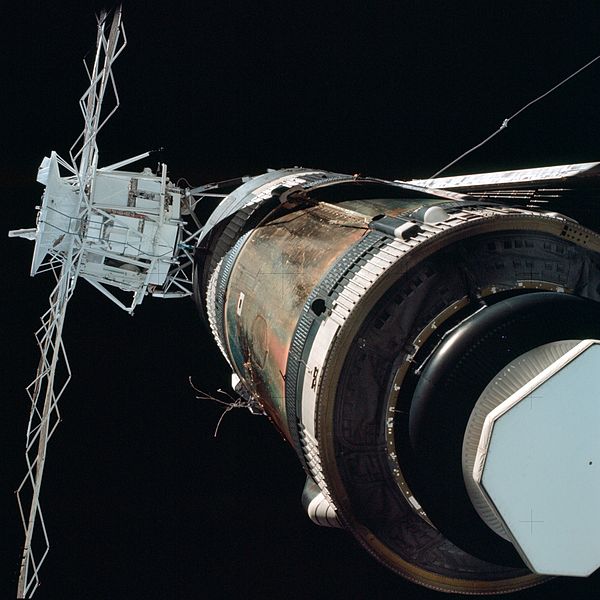
image by NASA (source)
^ The torn cables and tubing sticking out on the left side show where the shield had been torn away, exposing that large copper-colored surface. And you can see the jammed solar array on the right-hand side.
To fix the overheating problem, the crew of this repair mission deployed a gold "parasol" over the area originally intended to have been covered by the shield; you can see it in the first photo in this post, toward the bottom of the fuselage; you can also see there the solar array that was pinned now fully deployed (a second spacewalk two weeks later freed it, and finally got sufficient electricity flowing through the station), and (I think) the vacant spot on the other side of the fuselage where the other array would have been, had it not torn off during launch.
With the station habitable again, that crew was able to spend a few weeks engaged in research experiments, including the first detailed observations of the Sun with Skylab's instruments (more on that in the post linked at the top of this article!). In all they spent 28 days in space, which was a record for the time. Two more crews would work in Skylab over the next seven months, each setting a new record for time in space: 59 days for the second crew, and 84 for the third.
By Apollo standards, Skylab's interior was pretty plush. They had a full-sized shower, seen enjoyed here by a member of the second crew
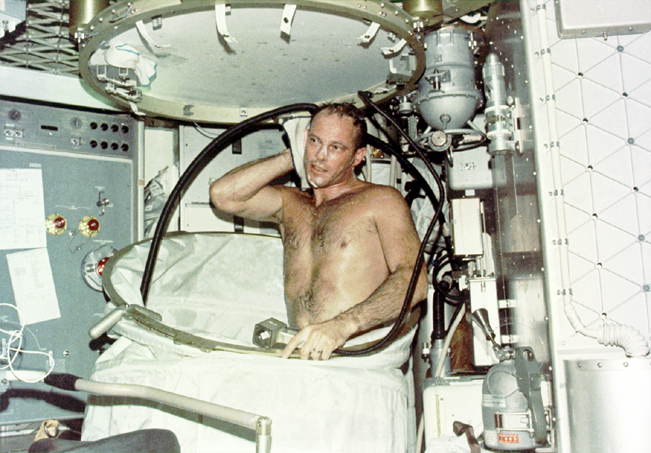
image by NASA (source)
(^ That image is from NASA's Great Images in NASA gallery; I posted some of my favorites from it on the A* forum some time ago--check 'em out, there's great stuff in there.)
Eventually though the crews found showering, drying, and vacuuming away the excess water in zero gravity rather difficult, and settled for just using damp washcloths instead. There's also an interesting note in the Wikipedia article that crews found bending and sitting in zero gravity puts an uncomfortable strain on stomach muscles--without gravity, you have to use your abdominal muscles to stay bent over... So in space, sitting is how you get really chiseled abs, maybe. Or maybe you just get really sore. Here's a mockup of the Skylab dining area from a Smithsonian exhibit; I guess the manikin isn't quite in a full sitting position:
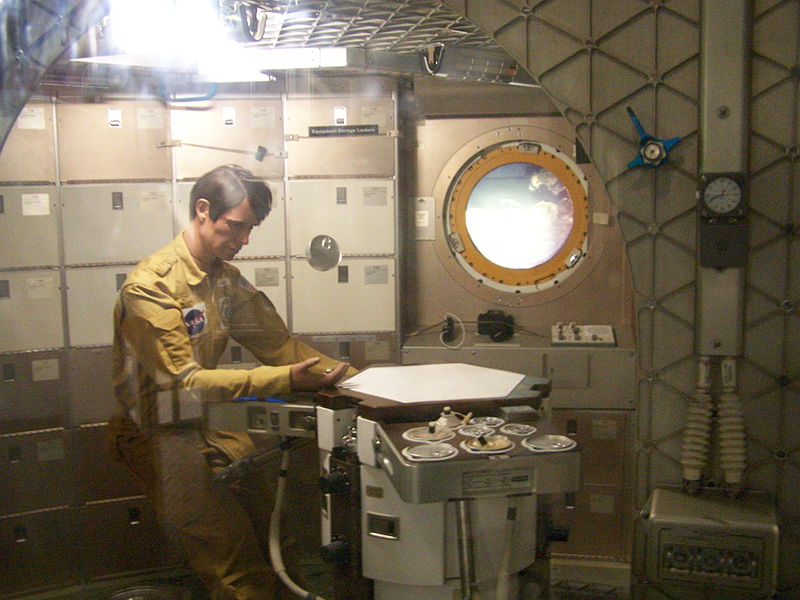
image by Steven Williamson (source)
Here's a 1972 NASA diagram of what it was supposedly all going to look like when inhabited; you can see that the big telescope is in the X-shaped solar array, that Apollo CSMs would dock at that end, and that yep, there would have been the second side solar array opposite the first, if it hadn't been torn off during launch (the "APPOLLO" typo is also fun :D--ooh, rocket science!):
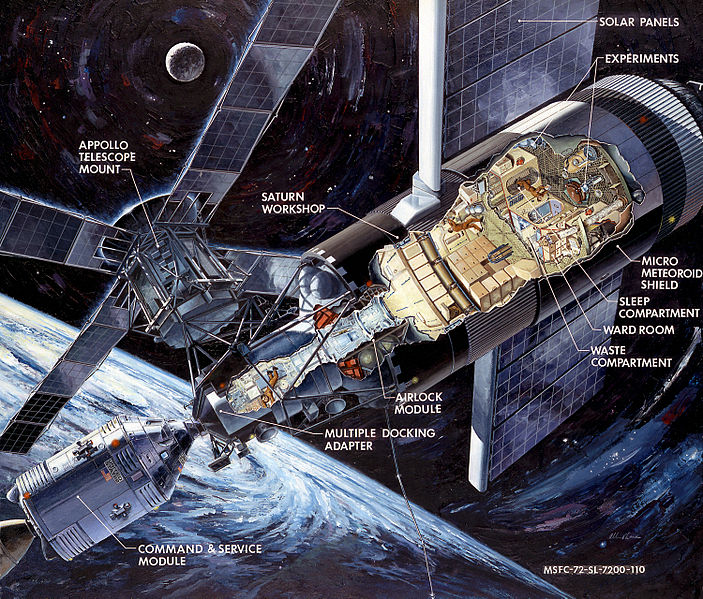
image by NASA (source)
And another diagram detailing the interior:
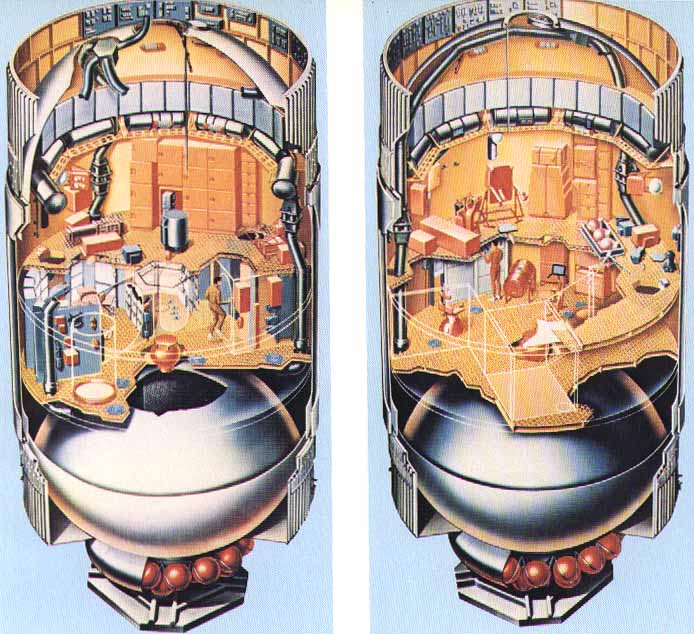
image by NASA (source)
Quite roomy by space program standards!
Skylab had launched in May 1973, and after those three manned missions, by February 1974, NASA felt that the station, over a year old, was getting too old to be safe for habitation--which seems like a quaint notion nowadays since we're used to say the International Space Station staying up there for years and years, but such was the feeling at the time. But with the Space Shuttle due to be ready in '79, subsequent studies concluded, by '78, that the station, now abandoned for four years, should still be inhabitable ("It still had 180 man-days of water and 420 man-days of oxygen, and astronauts could refill both; the station could hold up to about 600 to 700 man-days of drinkable water and 420 man-days of food"), and a gyroscope that had failed in the interim should be repairable; furthermore, the last crew on the station had boosted the station to an orbit 6.8 miles (10.9 km) higher, which was supposed to keep the station at a relatively stable orbit until at least the early 1980's. Shuttle missions could refurbish the station, and boost it to an even higher orbit, further extending its operational life.
But the Space Shuttle was delayed (the first Shuttle wouldn't launch until 1981), and then it became clear that the station's orbit would not last as long as had been forecast; ironically enough, an unexpected increase in solar activity--that field in which Skylab research had played such a key role--caused increase heating of the upper atmosphere, and thus higher drag on the station, causing it to slow--and thus fall. This increased solar cycle had been predicted in 1976 by the National Oceanic and Atmospheric Administration, but NASA had apparently ignored this, and instead had used what one NOAA scientist called an "inaccurate model" for predicting the solar weather and its effects. And even by late 1977, NORAD was able to predict that the station would re-enter the atmosphere in mid-1979.
NASA had been working on a booster system Shuttles would have attached to the station to boost it to a higher orbit, but it wasn't quite complete, even if they had been able to get some rocket missions ready to take it up to the station. There was nothing for it: Skylab was going to come down, and an international media frenzy began, with bets on where and when it would fall, and contests to be the first to recover pieces. Skylab re-entered the atmosphere on July 11, 1979. NASA tried to aim it for a spot in the ocean off South Africa, but their calculation of how fast it would burn during re-entry was off by 4%, and so pieces instead landed in Australia (NASA had also predicted that the chances of debris hitting a human being were "only" 1 in 152); some debris landed in the Shire of Esperance in western Australia (you know, it had never really occurred to me to consider that there are "shires" outside of Tolkien, such has been my isolation in shire-less regions of the US of A), who in retaliation fined the United States $400 for littering, which of course our government did not deign to pay--but finally in 2009 an American radio host "raised the funds from his morning show listeners and paid the fine on behalf of NASA." Aw.
Such is the saga of Skylab!
|
·····
|
| |
| Little Nemo in Embedland | Jul 28, 2011 11:57 PM PDT | url |
| | |
Added 1 new A* page:I've been a fan of Winsor McCay's fantastic old (1905-1914) Little Nemo in Slumberland newspaper comic strip for a while now, and yesterday I finally got around to watching the 1989 anime adaptation, which, although it involved such luminaries as Ray Bradbury and Moebius in the concepting and writing phases, has really as little to do with the original comic as could be. The characterization is all wrong (the princess is horribly snooty, for instance, and Nemo has been given a Disney-esque flying squirrel companion ;P), and the story is bad. So why am I linking a YouTube playlist of the full movie?
https://www.youtube.com/playlist?list=2B573B1CC3D0B0A1
Well I don't know. It had a tortured production, but it is at least animated well--by the Japanese studio that had just finished animating a rather better movie, Akira. Little Nemo was in fact the first anime with a nationwide theatrical release in the United States (but Akira was the first I saw).
(By the way I just recently added a "playlistembed" tag for embedding YouTube playlists on the A* forum. :D)
|
·····
|
| |
| Skylab X-rays the Boot of Italy | Jul 28, 2011 1:22 AM PDT | url |
| | |
Added 1 new A* page:Thanks to webcomics.biz (and the reader(s) who submitted my comic?) for listing A*, even giving it a little capsule review, and making a custom banner thingy for it. Neat! And they've also got an entry for my weekend fairy tale comic, The Princess and the Giant, so double-yay! :D
~~~~~~~
Well I talked up the current wave of fancy solar probes like STEREO, SOHO, and the SDO yesterday, but it was actually the old Skylab space station that verified the existence of coronal holes back in the '70s with orbital X-ray telescopes; Skylab's studies of the Sun in X-ray and ultraviolet frequencies, as well as others, provided a real breakthrough in solar research. Skylab didn't do so bad getting its own photos of those plumes from polar coronal holes, for instance:
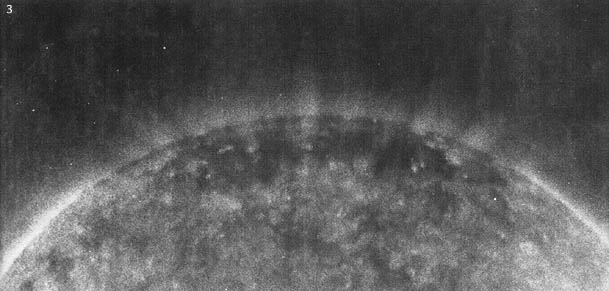
image by NASA (source)
One of the largest and most famous coronal holes found and studied by Skylab was the "Boot of Italy," so-named for its distinctive shape, and seen here by Skylab over a 6-day period:

image by NASA (source)
Here's another Skylab sequence, showing the evolution of what begins as a single huge coronal hole (the "Boot" again, I think), over a period of three months, again in X-rays:

image by NASA (source)
Skylab studied plenty of active regions, too; here's a nice X-ray photo from Skylab showing emissions from magnetic loops in the corona: "the seat of intense magnetic fields, where X-rays escape from heated gas trapped in magnetic loops that connect points of opposite polarity":
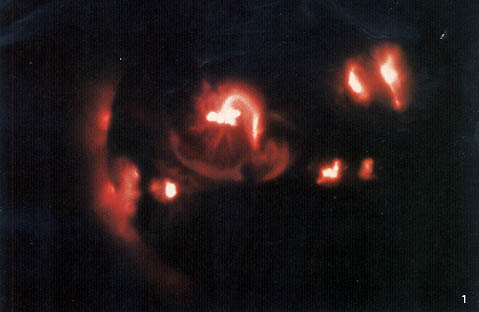
image by NASA (source)
And check out the second movie (mpeg format) down on this page for some nicely retro-looking Skylab video footage of a large coronal hole.
It is worth mentioning though that Skylab's weren't the very first X-ray photos of the solar corona; here's a composite of photos taken from rocket flights between 1963 and 1969:
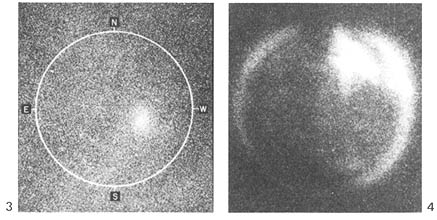
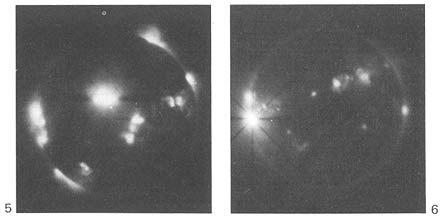
image by NASA (source)
All of those Skylab photos came from NASA's history site, which is well worth checking out for oodles more neat Skylab research results.
|
·····
|
| |
| Solar prominences and coronal holes | Jul 27, 2011 2:59 AM PDT | url |
| | |
Added 1 new A* page:Thanks to AnsuGisalas for linking to A* in a discussion thread on this TechRepublic article; it was something of a non sequitur, but I'll take it. :D
~~~~~~~~~
The recent string of posts on telescopes and the 1893 World's Fair and all that actually started, my notes just reminded me, with a post from mid-last-week on the then-mysterious event in May 1999 dubbed The Day the Solar Wind Disappeared. In that post I mentioned that later research suggested the almost complete shut-off of the solar wind in Earth's direction was due to active regions on the Sun's surface choking off the coronal hole through which the solar wind would otherwise have been issuing, and went on to explain that "active regions" are just areas on the Sun's surface where something is happening, aside from just the usual solar currents of heat and magnetism, and gave an example of sunspots as one such type of region.
But there are other types of active regions--and ones that make for much cooler pictures, too. For instance, a solar prominence is an extension of relatively cool plasma above the Sun's surface (and those "filaments" in the sunspot picture in the earlier article were types of solar prominences too, just viewed top-down so you couldn't really tell they were above the surface); some of them get really big, like this one seen from Skylab in 1973, which was called one of the largest ever recorded:
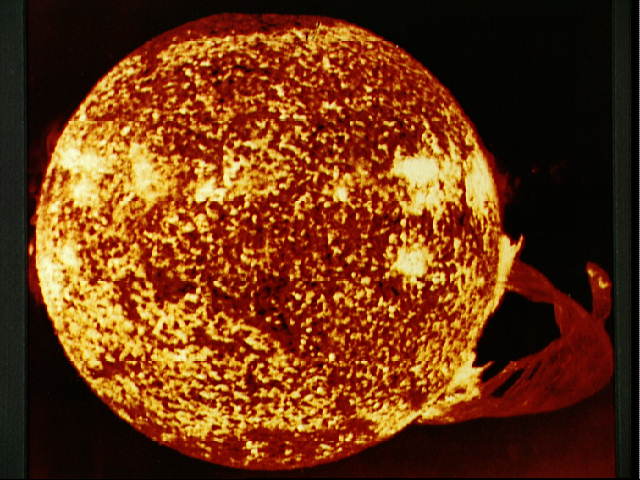
image by NASA (source)
Here's a somewhat smaller one seen by the Solar Dynamics Observatory in 2010, with Earth and Jupiter superimposed inside it to give some idea of the planet-eating sizes of these ribbons of plasma:
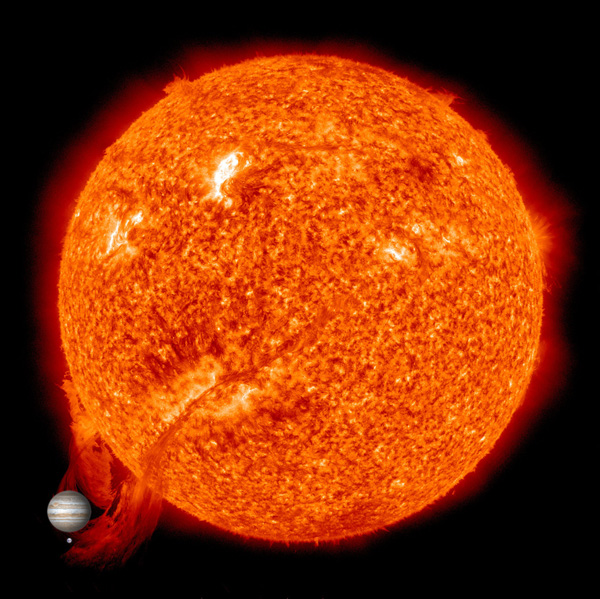
image by NASA (source)
And a coronal hole is more or less what it sounds like, I guess; these cooler, depressed areas of the surface are filled with much lower density plasma, and the solar wind comes tearing out of them along open magnetic field lines--"open" because they head out into space without looping back to the Sun's surface, which is why the solar wind can escape from those spots. Here's half of a STEREO image of one (that dark spot in the middle-ish; there are also some at the poles, but this isn't a great view of them), taken with its Extreme Ultraviolet Imager:
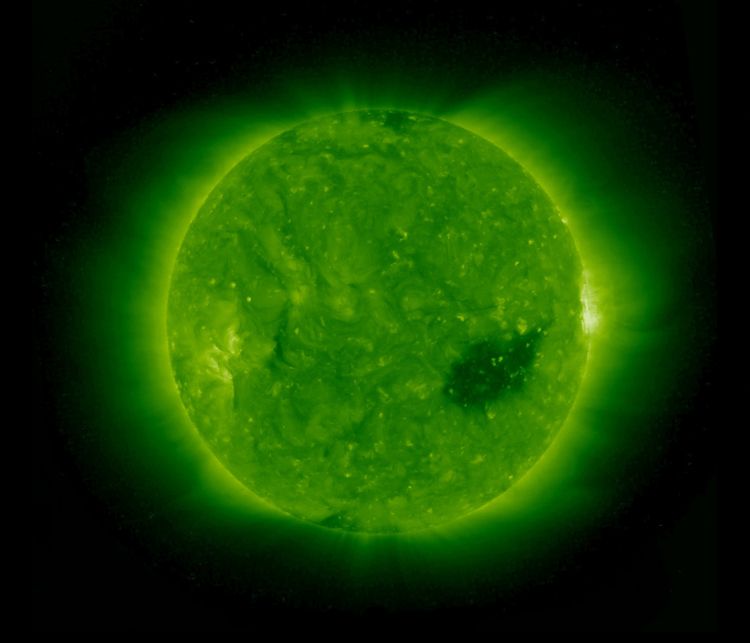
image by NASA (source)
The twin STEREO probes and the SDO are nifty space instruments; I've talked about them before here (with more big Sun images). Here's a massive coronal hole stretching across the top half of the Sun, as seen on February 1-3 of this year by SOHO in extreme ultraviolet:
video on Youtube
Not to be left out, there's also the ESA/NASA SOHO probe, which has taken some nifty extreme ultraviolet photos of solar-wind-borne plumes that extend out of large coronal holes that usually inhabit the Sun's poles:

image by NASA/ESA (source)
|
·····
|
| |
| The biggest (optical refracting) 'scope ever | Jul 26, 2011 2:36 AM PDT | url |
| | |
Added 1 new A* page:That huge telescope first shown at the 1893 Chicago World's Fair--the one I was talking about on Thursday, I mean--isn't the largest optical refracting telescope ever! The record was set by The Great Paris Exhibition Telescope of 1900, which had a whopping 1.25 meter lens! But at 60 meters (197 feet) long, the tube of the telescope was so big that it had to lie flat; it was really just made to wow people with SCIENCE at the exhibition, rather than for scientific observation--after the exhibition, nobody wanted to buy it, and it was broken up for scrap. Wikipedia says that the academic community of the time made it the butt of a lot of jokes--but apparently people visiting the exhibition were impressed, so it did what it was meant to do. And now I get to re-use it for this blog!
To give a sense of scale, this is just the part that held the eye-piece:
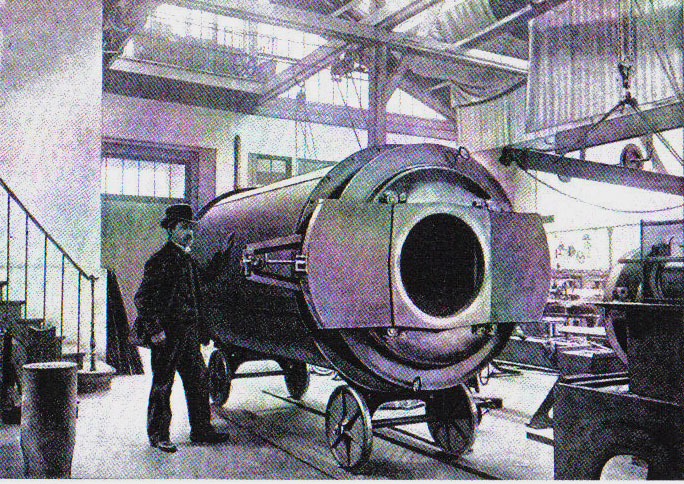
(source)
Since the nearly 200-foot-long tube had to lie flat, the idea was to use a 2-meter mirror on a swivel to direct light from the heavens into the horizontal lens tube:
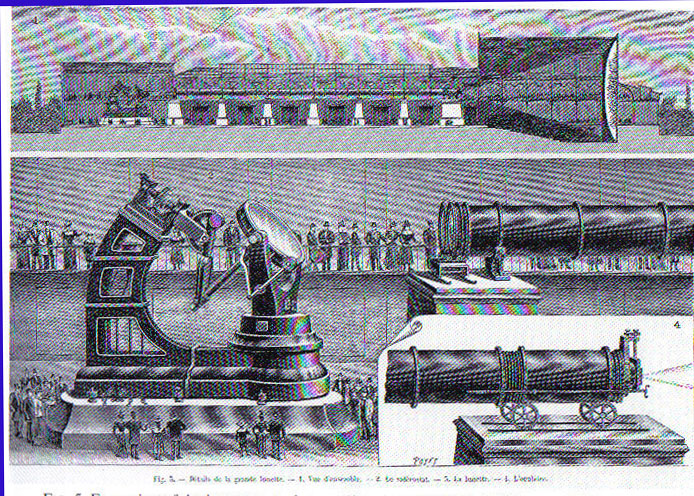
(source)
Here's what the tube looked like in place:
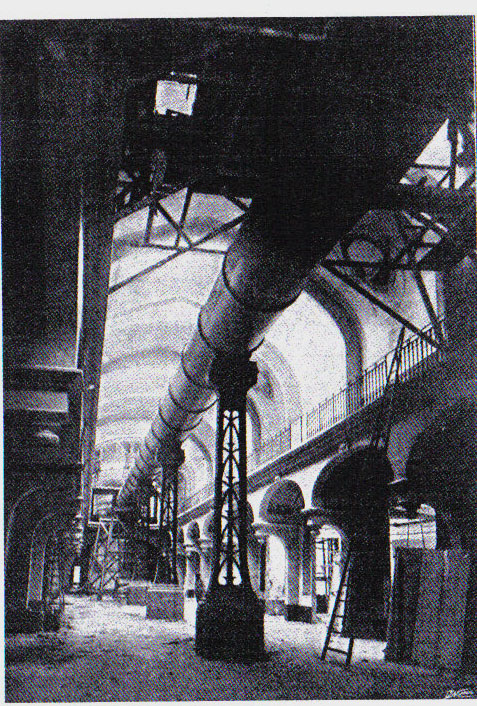
(source)

(source)
|
·····
|
| |
| Boring drawing and bad French | Jul 23, 2011 6:00 AM PDT | url |
| | |
Added 1 new A* page:I promise this will be the last "bored meeting" page (see that joke? man I'm good) we'll have for the foreseeable future. Monday's page will mark the start of a scene of a somewhat more intimate tête-à-tête.
If you were unlucky to be up and checking the site in the small hours of yesterday morning, you saw the first version I posted of the previous page; it looked like this:
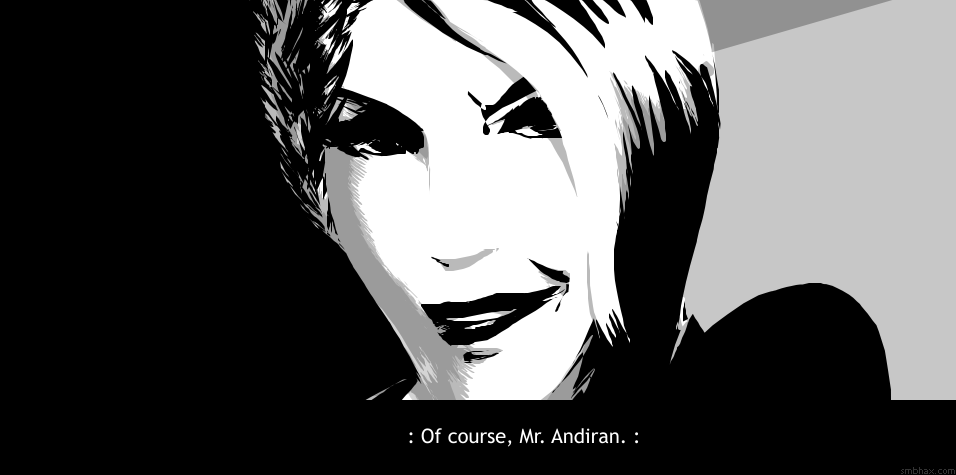
Compare with the version I replaced it with an hour or two later:

That first one was a later stage of the drawing, but once I posted it I realized (I was looking at the earlier stage and thinking I'd post it as an alternate version in the gallery with an oh-so-clever "why_so_sidereus" title...yeah that's an attempt at a "Batman: The Dark Knight" Joker joke years, after everyone already got sick of them :P) that hours of futzing with it--wanting to make the expression a little less scary, and trying to normalize everything and get it all proper and proportional, and then trying to give it some detailed lighting with intricate gray layers--had robbed whatever verve and expressiveness the drawing had had in the first place; it had become boring, and while perhaps technically more correct in some areas, left the eye with little to do but pick at the remaining discrepancies--whereas the earlier, rougher stage of the drawing, while oddly askew, googly-eyed, etc, at least suggests some unease and tension in a seemingly innocuous conversational exchange.
Or at least, so it seemed to me. So I pulled the earlier version of the black and white back up, cleaned up a few small glaring spots, redid the shading in a simpler, more straight-edged and straight-forward way that highlighted the black and white rather than trying to disguise it, and there it was--hopefully, a more interesting page. And hopefully this has taught me something. :P
~~~~~~~~~
But it's the weekend and school's out (well okay its also summer but uh some people have summer school probably and anyway don't try to analyze my analogies so much already!) so let's do something fun...um well on Sunday, because that's when I'll have a new page of my weekly fairy tale comic, The Princess and the Giant. Here's a teaser from last week's page that you can click to check out the full thing and get all caught up in anticipation:

Until then, mes amis.
|
·····
|
| |
| 1893 and the birth of the modern breakfast | Jul 22, 2011 6:09 AM PDT | url |
| | |
Added 1 new A* page:I mentioned yesterday that the Swedish Solar Telescope is the second-largest optical refracting telescope in operation. The *largest* optical refracting telescope in operation is the 102-cm 'scope at Yerkes Observatory in Wisconsin--operated by the University of Chicago, my alma mater! :); that telescope is an old one, having been exhibited at the 1893 World's Fair in Chicago before being installed at the observatory. Here it is installed in 1897:
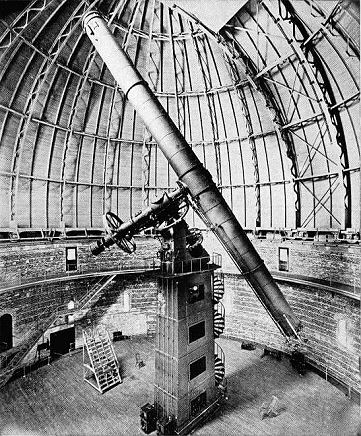
(source)
That World's Fair in Chicago was quite the humdinger, and not just because of that huge telescope. Some 200 buildings, mostly sporting a neoclassical style, were constructed for it; for the most part they were intended to be temporary only, and of all the buildings constructed for the Fair, only two remain: the Palace of Arts, now the Museum of Science and Industry--my college dorm was just one door up from the park in front of that huge place--and the building now occupied by The Art Institute of Chicago.
The Fair took place in Jackson Park and the Midway (just south and west of the Museum of Science and Industry on Chicago's south side; the Midway, continuing west from the Museum, forms the southern boundary of the main University of Chicago campus--I crossed it each day to get to my painting studio and classrooms in their old art building, a ramshackle affair supported at its core by the workshop of U of C art professor Lorado Taft, a famous sculptor in his own right, and a man instrumental in creating some of the monumental sculptures adorning those neoclassic buildings in the Fair; it was he who led the charge after the fair to restore the Palace of Arts, although he of course wanted it to be turned into a sculpture museum, which didn't happen--science and industry beat art in that one), which looked like this and this respectively, at the time:
The Midway:

image by E. Benjamin Andrews (source)
Jackson Park (Court of Honor and Grand Basin):

(source)
It was at this World's Fair that the AC--"alternating current"--electrical power pioneered by Nikola Tesla was first put to widespread use--by Westinghouse, to light all those buildings of the Fair's neoclassic "White City"; they had to overcome machinations by rivals Thomas Edison and General Electric, who in retaliation for losing the bid to Westinghouse had the use of Edison's light bulbs banned from the Fair--Westinghouse had to whip up a differently designed bulb just for the Fair, and the bulb they came up with replaced Edison's platinum (!) lead-in wires "with an iron-nickel alloy, thus greatly reducing the cost and increasing the life of the lamp."
That AC power and those iron-nickel alloy wires no doubt helped light up George Ferris' very first wheel, one of the biggest attractions, and one he hoped would rival the monumental Eiffel Tower sported by the previous World's Fair four years earlier in Paris--that might have been a bit optimistic; still, the ride obviously caught on:

(source)
Juicy Fruit made its first appearance at the Chicago Fair, and it was a landmark event in the history of breakfast, too, with Quaker Oats, Cream of Wheat, and Shredded Wheat all having their debuts. And okay who cares about that stuff, because it was at this Fair that Milton Hershey became fascinated with and bought German chocolate-making machinery then on exhibition, which he would use to produce his first chocolates to complement his successful line of caramels.
It was a fine day for science.
|
·····
|
| |
| Coming and going like the solar wind | Jul 21, 2011 5:54 AM PDT | url |
| | |
Added 1 new A* page:I think it was in looking for movies showing visualizations of the Sun's magnetosphere or something, in relation to the recent Voyager findings I was discussing last week, that I came across this video, showing visual readings from various NASA craft, etc, from May 10-12, 1999, which NASA called The Day the Solar Wind Disappeared:
video on Youtube
In that period, solar wind activity decreased by 98%, and electrons directly from the Sun's corona, usually broken up and dispersed by the solar wind, were able to shoot along magnetic lines to Earth in beams known as strahl, which is a funny word; these in turn came down Earth's magnetic lines to the poles, causing an unusual auroral event dubbed "polar rain." And in the absence of pressure from the solar wind, the Earth's magnetosphere was able to swell to over five times its normal size.
Interesting! But why this dramatic change, so dramatic as to cause some to say it shows the Sun is a "variable" star? In the end I had to go dig through some academic papers on the event by primary researcher P. Janardhan; in this 2008 paper, the team says that this was conclusive proof of "non-explosive" solar events having effects on "space weather" as far out as Earth, and concludes that (I may be understanding this wrong, mind you--there are a lot of charts and big words I don't quite follow) the cut-off of solar wind was caused by active regions on the Sun's surface magnetically connecting with, and effectively "pinching" off, the coronal hole through which the wind would ordinarily have been issuing.
This abstract of a later article headed by Janardhan mentions that similar "solar wind disappearance events" occurred in March and May 2002.
A stellar active region is just a fancy name for a place on the Sun's surface where something is going on other than just normal, relatively quiescent heat and magnetism; sun spots, for instance, are active regions characterized by a depressed altitude and temperatures as low as half of the surrounding surface, which causes them to look dark due to some black body radiation science I don't quite follow. The Wikipedia article notes that such areas on other stars are properly called starspots, and says that the Sun's are relatively tiny compared to those seen on other stars, which have been observed to cover as much as 30% of the star's surface!
Here's a nifty highly magnified view of a "planet-sized" sunspot from 2002; taken by the Swedish Solar Telescope in the Canary Islands, whose 98 cm lens makes it the second largest optical refracting telescope in operation, and which operates in a vacuum to prevent distortion by heated air--a particular problem for solar telescopes since all that light they take in heats things up; this was, at the time, the sharpest view of the Sun ever taken, and the first photo revealing long "filaments" going into a sunspot:

image by NASA (source)
|
·····
|
| |
| Man learns tools | Jul 20, 2011 7:16 AM PDT | url |
| | |
Added 1 new A* page:Phew well the whole standing desk thing seems to be getting better as I gradually get a handle on how to survive and work on my feet. Still working on the perfect desk setup, too; I even got some tools, have been ransacking the piles of old lumber in the basement, and my neighbors must be wondering what I'm up to as they enjoy the internal sounds of sawing, hammering, and sanding at all hours of the day and night. Whee! Two important things I've learned so far: make sure you get a level spot of floor--this is a challenge in this hundred-year-old-house--and make sure you get your working surface at the correct elbow height. Oh, and make sure your elbows are allowed to hang loose down by your side, not pushed back or pulled forward.
Obvious things, I know, I know. Anyway I seem to have survived another day of it, so the journey continues tomorrow! And hopefully soon I'll run out of things to spend all day sawing and hammering, and can get back to slightly more interesting news articles. :P
|
·····
|
| |
| Hello Vesta | Jul 19, 2011 7:01 AM PDT | url |
| | |
Added 1 new A* page:Thanks to an A* reader on Facebook for pointing me to updates on the Dawn spacecraft, which over the past few days successfully entered the first human-engineered orbit of an asteroid--the giant asteroid Vesta in the Mars-Jupiter asteroid belt--and then returned the first detailed photo of Vesta ever released from an orbital distance of about 15,000 kilometers:
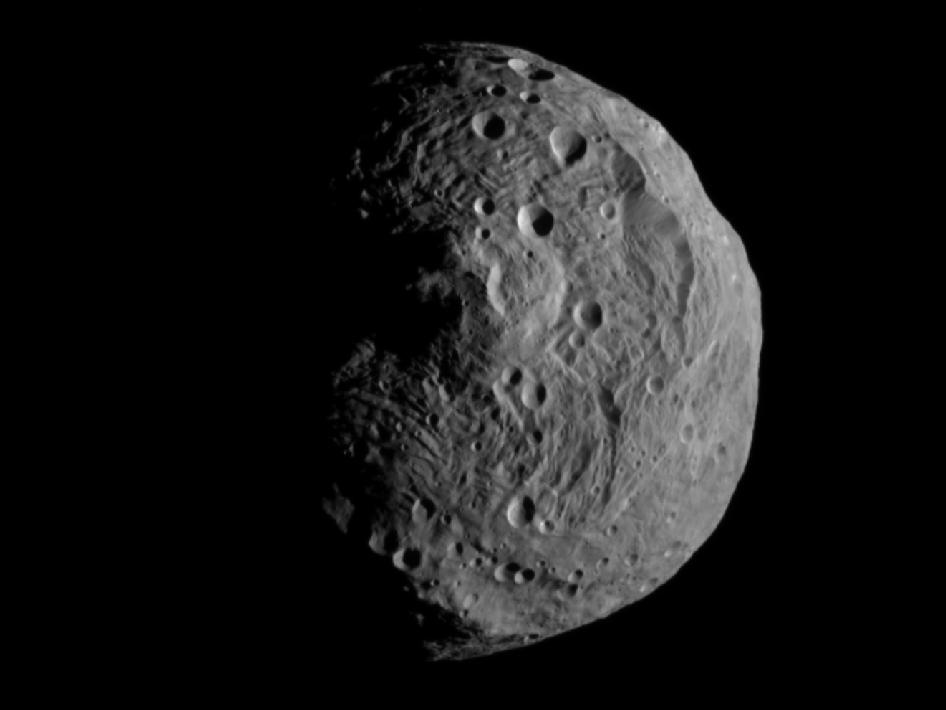
image by NASA/JPL-Caltech/UCLA/MPS/DLR/IDA (source)
Let the speculation begin: is Vesta, at 530 km in diameter, rounded enough by the pull of its own gravity to quality as a dwarf planet? Looks pretty irregular along the right side in that photo, but I have no idea exactly how regular it would have to be--hopefully the smart people will be figuring that out shortly, although I wouldn't be surprised if any official status change takes a while.
That second article mentions that Dawn "also accomplished the largest propulsive acceleration of any spacecraft, with a change in velocity of more than 4.2 miles per second (6.7 kilometers per second)..." The Wikipedia page clarifies the significance somewhat:
| To get to Vesta, Dawn is allocated 275 kg (606 lb) xenon, with another 110 kg (243 lb) to reach Ceres, out of a total capacity of 425 kg (937 pounds) of on-board propellant. With the propellant it carries, it can perform a velocity change of over 10 km/s, far more than any other spacecraft has done with onboard propellant after separation from the launch rocket. Dawn is NASA’s first purely exploratory mission to use ion propulsion engines. |
Because those ion engines are so efficient, Dawn is capable of far more independent propulsion than any other spacecraft. For instance, Dawn began "long-term cruise propulsion" on December 17th, 2007, and completed that first thrusting phase on October 31, 2008; "Dawn spent 270 days, or 85% of this phase, using its thrusters," and "expended less than 72 kilograms (158 pounds) of xenon propellant for a total change in velocity of 1.81 kilometers per second (4050 miles per hour)." Hm! Now they gotta get some you can use from cars on long freeway trips, and we'll have this energy crisis all taken care of.
|
·····
|
| |
| And thanks for the links! | Jul 16, 2011 8:52 AM PDT | url |
| | |
Added 1 new A* page:Well it's been a long week--too long for the likes of me, who in the middle of whatever night this is decided he was tired of chairs and all their bars and lumbars and so forth, and would henceforth draw A* standing up. >_>
So as another morning of vigorous hammering commences on the fancy new garage my new neighbors across the street are having built, it's off to the land of nod for me, so I can rest and rejuvenate not only for what intrigue may await us at the Andiran research station's staff meeting next week here at A*, in which we can already see that Selenis is confronting her target, Andiran himself, but also to draw another page in the little soundless saga known as The Princess and the Giant, an odd fairy tale adventure I update on Sundays; here's a sampler from last week's page--click the banner to go to the full page if you dare:

~~~~~
I noticed I got some traffic from a few new sources in the past couple days, so thanks are due! Thanks to dmz001 for including A* in his public bookmarks on delicious.com! And thanks to DraQ for posting a link to A* on the Elite PL BBS, a Polish bulletin board which appears to be dedicated to all things Elite--the classic space simulation I was babbling about in this blog recently. Thanks, thanks, thanks for the links! :D
|
·····
|
| |
| Inside the Orion Nebula | Jul 15, 2011 7:44 AM PDT | url |
| | |
Added 1 new A* page:Yesterday in talking about bow shocks around stars, I mentioned the star L.L. Orionis, in the Orion Nebula. The Orion Nebula (aka M42, or Messier 42), the closest region of intense star formation to Earth--1,350 light years distant--is bright enough to be seen by the naked eye from the Earth's surface; curiously though, it wasn't seen as a nebula by any stargazers until the 17th century, leading to speculation that its current luminosity may be due to a recent flare-up of young stars. Previously it was seen as a star, and was made the middle "star" in the belt of the constellation Orion.
Being the closest significant stellar nursery, the nebula has been the object of much study, and a rather well known Hubble photo. I posted a larger version of it some time ago on the forum, along with detailed photos of the "proplyds"--baby stars with protoplanetary discs: solar systems just starting to form--Hubble spotted within it. But I'm going to repost that because it's a nice one, and then a bunch of other photos, because it's such a pretty nebula.
Interestingly, its areas of green tint puzzled astronomers who observed it early in the 20th century, because that color didn't come from any known emission lines; but now we know that the color is due to what is called a forbidden transition in doubly ionized oxygen. A "forbidden" transition is really just a very unlikely electron transfer, with a very low quantum probability under normal conditions; it turns out that what we on Earth had considered "normal" doesn't necessarily apply in the near-vacuum of deep space. To quote the Wikipedia entry:
| Forbidden emission lines have only been observed in extremely low-density gases and plasmas, either in outer space or in the extreme upper atmosphere of the Earth. Even the hardest laboratory vacuum on Earth is still too dense for forbidden line emission to occur before atoms are collisionally de-excited. However, in space environments, densities may be only a few atoms per cubic centimetre, making atomic collisions unlikely. Under such conditions, once an atom or molecule has been excited for any reason into a meta-stable state, then it is almost certain to decay by emitting a forbidden-line photon. Since meta-stable states are rather common, forbidden transitions account for a significant percentage of the photons emitted by the ultra-low density gas in space. |
So doubly ionized oxygen won't give off a greenish glow on Earth, except maybe under the most exacting of laboratory conditions--but in space, particularly in the Orion Nebula, green is go! Some early astronomers, not being able to reproduce such conditions, thought the green tint might be a sign of a new element, which they speculatively named "nebulium"--but it is in fact just oxygen.
Okay, on with the photos. We start as I started to say with the famous Hubble view of the nebula, showing its 24-light-year extent:

image by NASA/ESA/STSI (source)
L.L. Orionis (aka "LL Ori") and its large bow shock are barely visible there, just below center. Let's take a closer look; you can see L.L. Orionis and its bow in pink just up and left of center here:

image by NASA/ESA/STSI (source)
So what's causing that bow shock around L.L. Orionis? A stream of gas coming from the center of the nebula, propelled by hot young stars. The biggest of them form the bright lights of the small Trapezium Cluster, which gets center stage in this photo (L.L. Orionis is in the lower right):

image by NASA/ESA/STSI (source)
The most massive of them is Theta-1 Orionis C, the lowermost of the bright white stars visible in the tight cluster at the center of that image. It has the highest surface temperature of any star visible to the naked eye: 45,500 K (compare to the Sun's 5778 K); this is slightly cheating, however, as close observation has shown that it is actually a binary of two stars that are very close together. Its ultraviolet emissions account for most of the glow of the entire nebula; its stellar wind is 100,000 times as strong as the Sun's, propelling gas outward at 1000 km/s (0.3% light speed! :o).
Here's a nifty comparison from Hubble showing the Trapezium and their nebular surroundings first in visible, then in infrared light: the infrared goes right through all those clouds of gas and dust, revealing loads of little baby brown dwarf stars hidden within!

image by NASA/ESA (source)
Here's a neat false-color (the colors represent different types of ionized gas) image that gives a good idea of the nebula's bell shape, the cone of the bell being blown open by its "clapper," the Trapezium cluster, if you will:

image by ESO (source)
Here's a nice false-color one of infrared light by NASA's Spitzer Space Telescope:
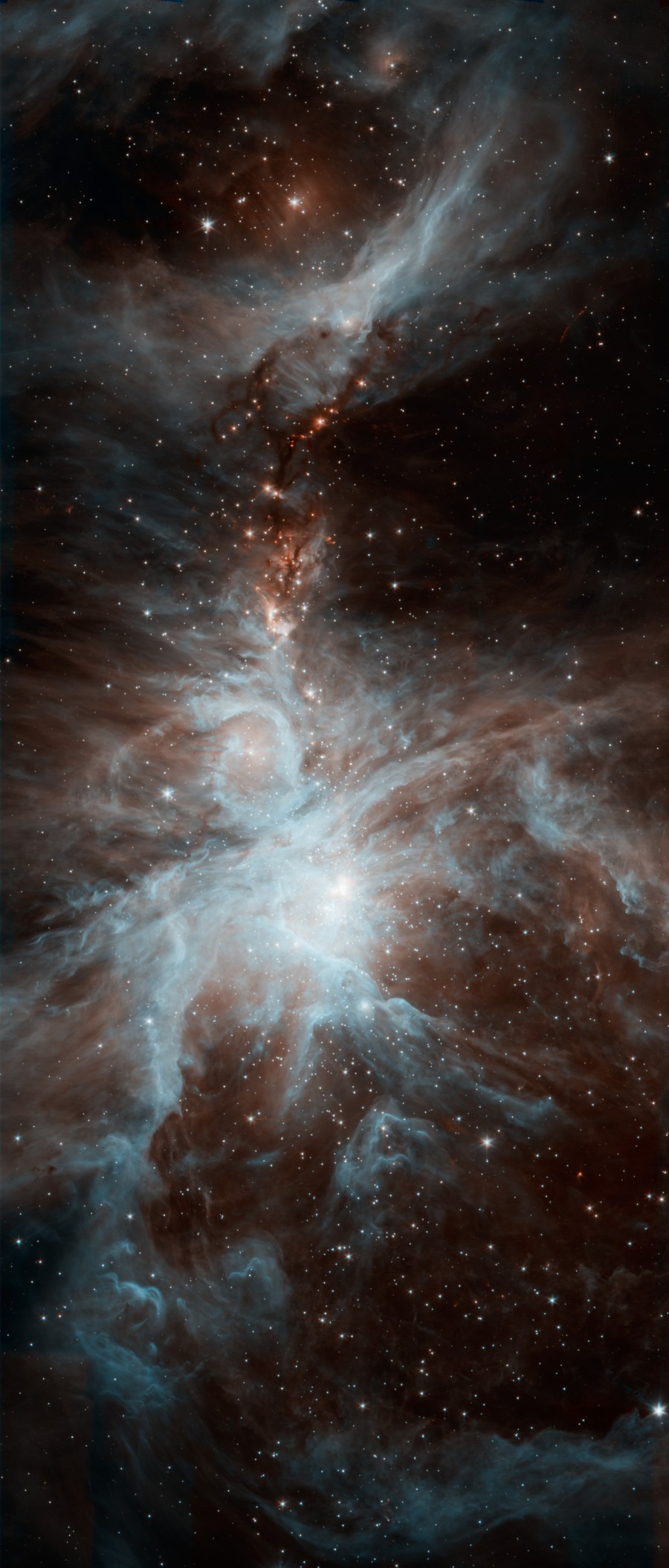
image by NASA (source)
Man I'm being high-bandwidth today! I hadn't realized it before, but the Spitzer telescope, launched in 2003, ran out of liquid helium coolant in 2009; without coolant, it can only use its two shortest wavelength infrared camera modules effectively--this is called it's "warm mission," and still capable of some great images, as the one above can attest!
That being said, here's another false-color infrared view of the nebula, this one from one of those high-altitude ESO observatories in Chile:

image by ESO/J. Emerson/VISTA (source)
And if you really want to be blown away, try the "source" link for that one--the original is over 12,000 pixels wide! And you can see loads and loads of bow shocks and eddies and things on the little baby stars inside the nebula, like so:
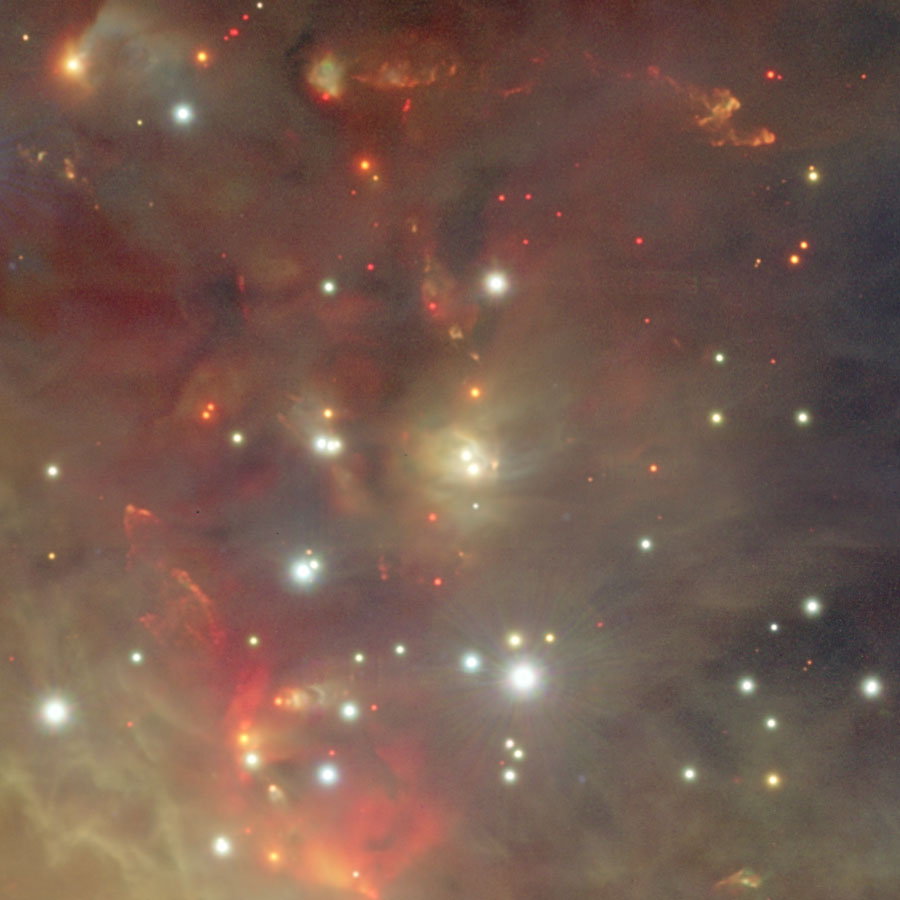
Awww. :)
|
·····
|
| |
| Surfing the frothy edge of the Solar System | Jul 14, 2011 5:44 AM PDT | url |
| | |
Added 1 new A* page:Those intrepid 33-year-old Voyager spacecraft have been making some startling discoveries way out on the edge of our Solar System, as they continue to wing their way out toward intergalactic space.
First, fluctuating readings picked up by Voyager 1--the further out of the two--since 2007, and Voyager 2 since 2008, are now thought to indicate that the Sun's magnetic field gets "frothy" out near the furthest reaches of the solar wind, with lines of magnetic force criss-crossing, reconnecting (apparently magnetic field "reconnection" is also what causes solar flares in the Sun's atmosphere), and forming "bubbles" up to 100 million miles wide (which makes such "bubbles" larger than the distance from the Earth to the Sun, which is about 93 million miles, or 150 million kilometers), some filled with trapped cosmic rays and electrons.
This "foam" or "froth" idea--the readings from the probes don't appear to be absolutely definitive on the theory thus far--stands in significant contrast to the previously prevailing notion of the boundaries of the Sun's magnetic field, which was thought to spiral out gracefully in nice big arcs that eventually curved back to the Sun. Here's NASA's visual comparison of the two competing views--the red and blue lines represent the Sun's magnetic field, the blue areas represent the heliosphere--the bubble "blown" out of the galactic medium by the Sun's solar wind, the inner, greenish blue area ending with the "termination shock," where the solar wind collides with the interstellar wind and loses its supersonic speed--and the orange vapor surrounding it represents the interstellar wind:
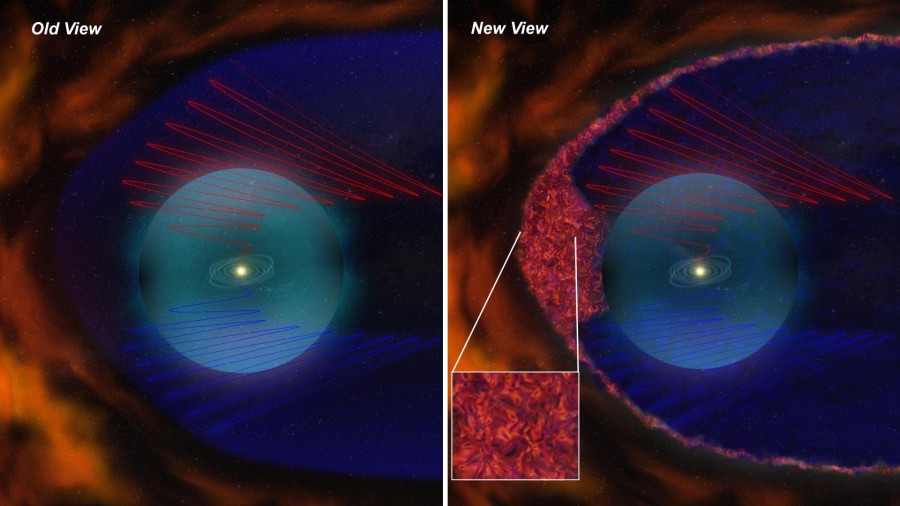
concept image by NASA (source)
The shape of the outer magnetic field could have significant effects on life on Earth: a magnetic "froth" around the Solar System might be helping to keep out high-powered cosmic rays, which would otherwise be shooting their super-charged particles through our fragile bodies much more frequently than they do now. Or, the bubbles could form gaps that allow more cosmic rays through--scientists aren't sure yet.
The Voyager craft are the first ever to reach this very edge of the Solar System, so this is the first time direct data of the magnetic field that far out has been gathered--so it isn't surprising that the rule books may have to be re-written a bit.
I thought the part about the path cosmic rays take to get to the inner Solar System was interesting; I hadn't realized that they come in along magnetic field lines! I had thought they just zinged straight through on the strength of their own momentum or something.
NASA followed up that first Voyager article with another one less than a week later, about how the probes are helping recalculate the distance to interstellar space: since December 2010, Voyager 1's instruments have shown that the solar wind around it has slowed to a standstill, "marking a thick, previously unpredicted 'transition zone' at the edge of our solar system"; this boundary is now thought to be "between 10 and 14 billion miles (16 to 23 billion kilometers) from the sun, with a best estimate of approximately 11 billion miles (18 billion kilometers)."
That 11 billion miles figure is about where Voyager 1 is now, so in theory it could cross into interstellar space--where the solar wind and magnetic field from the Sun drops away entirely, leaving the probe to move through the galaxy's thin interstellar medium--at any time now. "Voyager 1 speeds outward a billion miles every three years," so it can't be much longer now--or so prevailing theories suggest. There's also the question of whether the probes will find a "bow shock" around the solar system, ie a compression of the interstellar wind as it collides with the solar wind; such bow shocks definitely exist, and have been observed around other stars, such as this half-light-year-long (~5 trillion kilometer) one that has formed between the star L.L. Orionis and the surrounding Orion Nebula:

image by NASA (source)
|
·····
|
| |
| COMET-SUN APOCALYPSE OMGEEZ!!! Also, Bowie. | Jul 13, 2011 7:17 AM PDT | url |
| | |
Added 1 new A* page:In testing out a new theoretically ergonomic drawing arrangement, I ended up drawing a picture of Selenis, somehow looking rather David Bowie-ish. You can click this tiny version for the full-size one in the episode 13 gallery:

Galleries can always be accessed from the "episodes" link in the site's top menu!
~~~~~~~~~
I noticed a Space.com article overnight that tried to make a NASA article sound much more dramatic, and probably overstated the facts, strictly speaking. Not that anyone else we know of does this on a regular basis... >_> Anyway the Space.com article is Comet's Death by Sun Photographed for First Time; the actual NASA article they got their stuff from is First-Ever View of a Sungrazer Comet in Front of the Sun--since they didn't actually catch what happened to the comet, exactly. Sure, it probably evaporated, but only crazy non-scientists would leap to that conclusion and repost the suggestion as fact! Whee!
The comet was caught by NASA's SOHO Sun-studying craft, which you may recall I wrote a bit about in mid-May. It is very good at spotting all these comets plunging toward the Sun--and boy, I guess there are a lot of them.
And a nice still image of its approach:
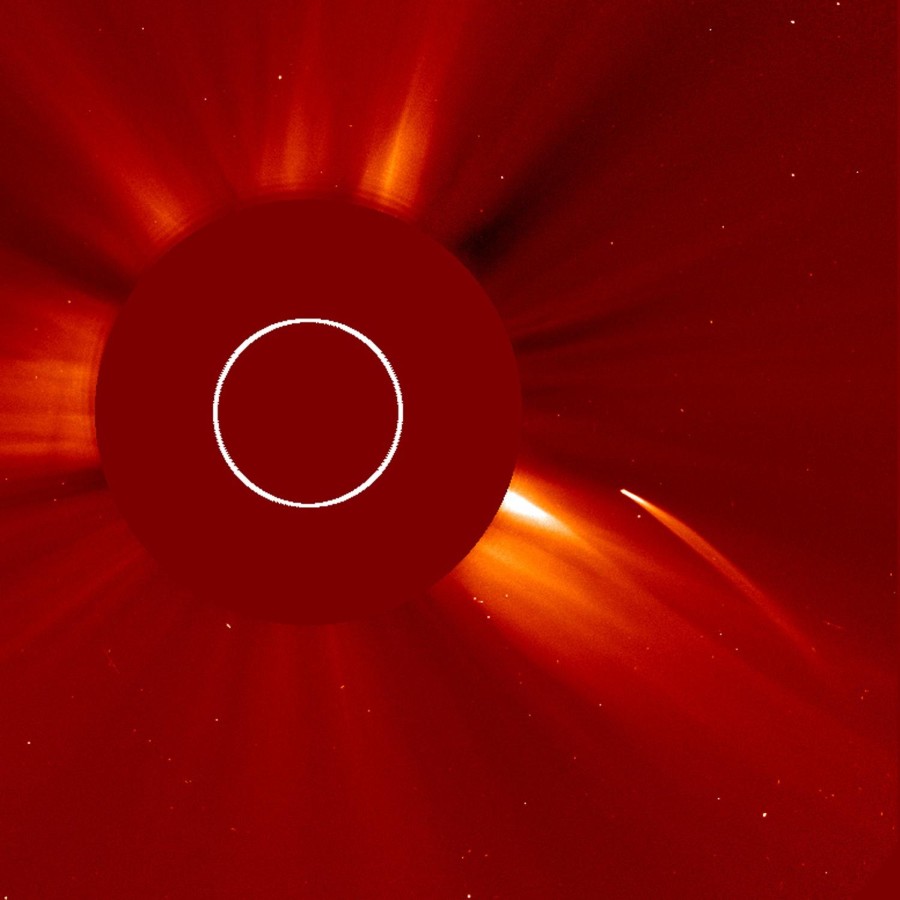
image by ESA/NASA (source)
So there, I am such a big man I will spend a blog entry trying to one-up another site in swiping and regurgitating NASA's news. Yessssss. But anyway SOHO's stuff makes for some nice pretty pictures.
|
·····
|
| |
| Back to the school desk | Jul 12, 2011 6:55 AM PDT | url |
| | |
Added 1 new A* page:I have to thank blog author Jason of Carpe Chaos for including A* on his reading list some months back. He also had some interesting things to say about the comic, and the experience of reading it. Much appreciated!
~~~~~~~~~~~
I've been struggling to find a new work chair for the past week or so since finding my old one of however-many-years was slowly murdering my leg muscles (although this may be related to having a swivel chair on a rather uneven floor :P), and I was coming to the conclusion that the proper type of chair for tablet-using computer artists simply did not exist.
See back in the day (1893 Norway, for instance), there were drawing tables (or drafting tables or whatever you call 'em):
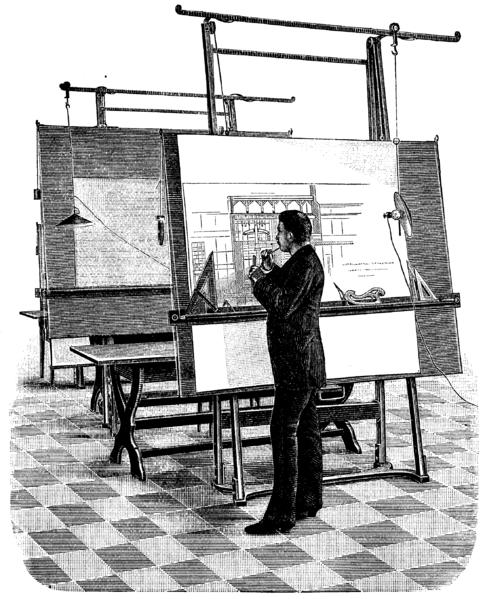
(source)
(By the way, the Wikipedia drawing board page mentions that the "back to the drawing board" expression was actually coined in a comic! A 1941 entry in The New Yorker by Peter Arno, and you can see the comic right here.)
And illustrators still seem to use drawing tables--I have seen artists leaning on them in photos! Not that I seem to have any of said photos handy...--although nowadays they're much more horizontally inclined; but I guess the idea is you have maybe a sort of high stool, and then you lean your elbows on lower part of the tilted table surface, and draw on it. This seems wrong for all sorts of ergonomic reasons, but it definitely does one thing right that I have rediscovered on the past day or two is of prime importance in a drawing workspace: keeping your wrist straight while drawing!
Now in this newfangled electronic age, people have had the idea of perching computer monitors at the high ends of those tables, and maybe sticking a retractable shallow drawer at the low end for a keyboard to sit in, as in this model, but I wonder how well that works. After all, the point of a drawing table is to look at the table as you draw on it, but when you're using, say, a tablet for computer drawing, you're not looking at the tablet, but at the screen, and trying to look up while drawing with the tablet propped on a regular drawing table seems like it'd be asking for major neck cramps, at the very least.
A year or so ago I asked a bunch of other webcomic artists what they use to support their drawing surface, and particularly for tablet users, the answers sounded ergonomically terrifying--I think all current webcomic artists will be arthritic wrecks within the space of five years, if the answers I got were at all representative. An entire industry doomed due to lack of proper furniture not having been invented for it!
But then I got to thinking of my old school days, and how we had those desks that would swing in along the side, so you could prop your elbow on them, and then go out to form a nice desk surface in front, all in a single table piece--those were good for drawing, AND they were meant for writing (or drawing, if the teacher wasn't looking) while predominately looking forward, which would work for working on a computer screen. And behold and lo, they still make desks like those, and even in left-handed varieties.
Now you will laugh, but I am seriously considering getting one of those. I guess it will depend on whether or not I can work out a wrist-friendly tablet support position with my current new chair (this would be new chair number 4 now ;P)--the main problem being, I think, the lack of a real connection between armrest and tablet support surface--which is exactly what those old school desks did so well, and why I am kinda wanting one here in my dotage. Sure it probably doesn't have super-keen lower back support, and is probably all the wrong sizes (although the listed dimensions don't look that bad on paper), and lacks any kind of rest for the other arm (that could be a real problem, since I have to use my keyboard once in a while :P), but dang, that tablet arm (they're even *called* "tablet arm" chairs!) looks so nice right now.
|
·····
|
| |
| Attack of the Time Lords | Jul 09, 2011 6:23 AM PDT | url |
| | |
Added 1 new A* page:The weekend has arrived! Do consider stopping by my weekly fairy tale comic, "The Princess and the Giant," on Sunday for its regular update. And here's a handy link banner to take you to last week's, if you missed it:

~~~~~~~
A little while back an idea for a short interlude or flashback episode popped into my head; I thought initially of doing it after episode 14, but I think the end of episode 13 will actually be a better spot for it. So maybe that's what I'll do! It would be about a dozen pages, and would show us an important point in the life of Selenis...0. And actually after I thought of that, a whole bunch of nifty ideas about how to tie some other back story stuff into eventual story stuff popped into my head, so that was an opportune thing to think about at the time.
Anyway I'm getting ahead (or behind?) of myself, since we've still got...hm...just under 100 pages left in this episode. Will Gliese be spared? Will Selenis ever get out of his boring old office? Will she ever get back to going after her supposed target, Kol Andiran? The answers to these and other burning questions of space and time...next week!
|
·····
|
| |
| Dawn on Vesta | Jul 08, 2011 5:49 AM PDT | url |
| | |
Added 1 new A* page:Today (technically; this is still Thursday's page, though :P) the Space Shuttle Atlantis will launch on what will be the final Shuttle mission. To quote from the article: "The space shuttle program was born in 1972, when President Richard Nixon announced its existence to the nation. The orbiters started flying in 1981 and will have made a total of 135 flights when Atlantis' wheels finally roll to a stop later this month." It's going to be kind of weird not having the Shuttles doing their thing anymore.
~~~~~
But mostly today I want to talk about NASA's Dawn spacecraft! It launched in September, 2007, and will finally be arriving at its first destination, the giant asteroid Vesta, on the 16th of this month! It was a slow trip (and that was *with* a gravitational boost from Mars in 2009), but that's because Dawn is powered by ion drives, which are really efficient, but not very powerful; however, their efficiency will really pay off--eventually--for Dawn, since it will be the first spacecraft to be able to orbit two bodies: after orbiting Vesta for a year (according to this NASA article from May), it will proceed on to the largest body in the asteroid belt, the dwarf planet Ceres, reaching it in February 2015.
Dawn may actually make a dwarf planet out of Vesta, since its investigation of the asteroid will show once and for all if Vesta has acquired a sufficiently rounded shape from the weight of its own gravity, which is required for dwarf planet status. Vesta is about 530 km in diameter, the second-largest body in the asteroid belt, containing an estimated 9% of the belt's mass; Ceres, at 950 km in diameter, contains about 32% of the belt's mass. Here's a handy chart--stolen from Wikipedia, like nearly everything else here--showing their sizes relative to the Moon:
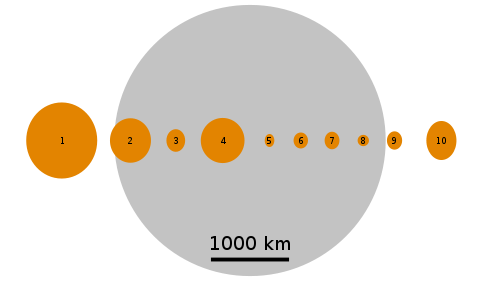
image by Vystrix Nexoth (source)
^ "Sizes of the first ten Asteroids to be discovered compared to the Earth's Moon, all to scale. The dwarf planet Ceres is on the far left. The remaining objects, left to right are: 2 Pallas, 3 Juno, 4 Vesta, 5 Astraea, 6 Hebe, 7 Iris, 8 Flora, 9 Metis and 10 Hygiea."
Vesta is known to lack roundness at its south pole: that was knocked off relatively recently--less than a billion years ago--by a big impact that left behind a crater 460 km in diameter, with walls 25 km high. Fragments from that impact have come to Earth as meteorites, so we actually have a pretty good idea of Vesta's chemical composition, thanks to studies of those bits that have landed here.
Still, little is known about what Vesta and Ceres--these giants of the asteroid belt--actually look like! The best photos Earth-based telescopes--and even orbiting ones like Hubble--have managed are blurry things, like this one of Ceres from the Keck Observatory:
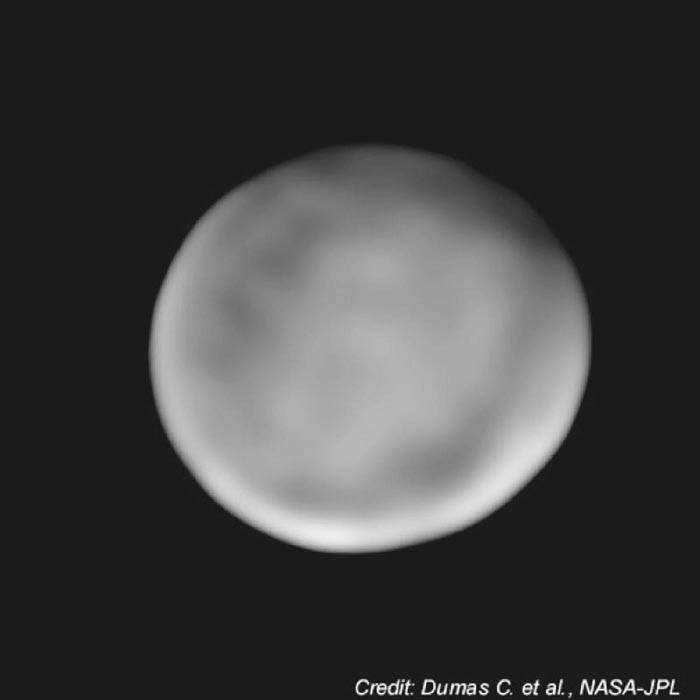
image by NASA (source)
But Dawn's already changed that, at least for Vesta! Here's a shot it took on July 1st, when it was about 100,000 km away from the asteroid:
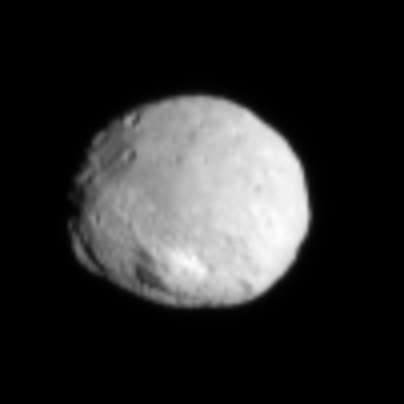
image by NASA/JPL-Caltech/UCLA/MPS/DLR/IDA (source)
By the way, it's a little dated now, but if you want a bit more from me (why? :P) on Dawn, Vesta, and Ceres, there's this article I wrote up about them over a year ago, with some other nifty photos and diagrams.
And we should have much better photos of the possibly-soon-to-be-dwarf-planet in a matter of days, whee!
|
·····
|
| |
| Braben, Elite, and Raspberry Pi | Jul 07, 2011 5:41 AM PDT | url |
| | |
Added 1 new A* page:If you look closely on the left side of the screen Mother is showing Selenis on page 7 of this episode, you'll see what I meant to be a sort of 3D schematic of the Hertzsprung star system in which this Andiran Robotics space station is located; vertical bars off of the horizontal plane are used to represent distance above or below the ecliptic (or perhaps rather the system's invariable plane, which is something I just learned about in making sure I was using "ecliptic" properly--I wasn't *quite*).
Ooh! Here's a nifty photo taken by NASA's 1994 lunar probe Clementine (a craft I have mentioned before), showing--from right to left--the Moon, the Sun, Saturn, Mars, and Mercury roughly in a row near the Earth's ecliptic plane and our system's invariable plane:
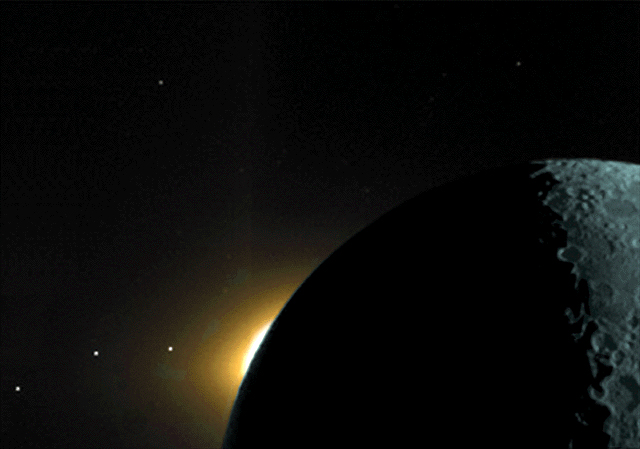
image by NASA (source)
Anyway, I got the idea for those vertical bars in the system schematic from an old space sim I played on my family's Commodore 64 computer as a tad: Elite, which was at the time (1984) an amazing 3D (!) simulator of interstellar trade, where you flew a space ship between star systems, buying and selling for profit--and in between you had to fight off pirates, maybe the police if you were naughty, and the rare alien invasion. In a way this single 5 and a quarter-inch floppy affair was a very bare-bones game, but the real draw was just how open-ended it was: you could go pretty much anywhere in the galaxy as long as you had the patience, and you could do whatever you wanted as long as you could survive the consequences.
Elite was made by David Braben and Ian Bell, and part of the reason why I bring all this up is that I recently stumbled across a BBC video of a recent Braben project: Raspberry Pi, an entire tiny computer--about the size of a USB thumbdrive--that Braben says will cost about $25 per unit, enough to be given to every kid in school. Here is the video of him showing it off and talking about it (WARNING: video on the following page auto-plays with sound): viola.
I was interested not only in seeing what he looks and sounds like, but also how enthusiastic an advocate he is of teaching kids the basics of computer programming, which he points out really isn't done at all anymore (what, they don't make kids learn Logo (I think that's what it was...at the time we just called it "Turtle") in school anymore? lucky punks :P); non-UK viewers such as myself may like to know that the "ICT" he mentions as being taught instead of programming is Information and Communication Technology, a subject in the UK's national curriculum that teaches the use of office suites and desktop publishing software, apparently; Braben blames ICT for ousting computer programming as a subject and causing what he says was a 50% decline in computer science majors in the early 2000's.
As you can see from his Raspberry Pi prototype, Braben loves to make impressive computing in tiny packages. "Elite" was written in machine code, which was important because it gave them more options on their development machine, which had just 14 KB of memory. Ah, and according to the Wikipedia article, the 3D radar display I stole for that A* page was the last thing they added, to take up the last few unused bytes. And I hadn't known this before, but machine code is writing in the computer's actual 1's and 0's (or whatever), as opposed to an assembly language, which "uses mnemonic codes to refer to machine code instructions"--I had always thought assembly was the 1's and 0's, but now I know better!
Speaking of assembly, though, that's what Braben used for writing the first Elite sequel, 1993's (yes it was a long wait) Frontier: Elite II. I played Frontier on the Amiga, which happened to be its native format (good choice, David! :), and if I had thought the original Elite was impressive in fitting I don't know how many star systems--although their space stations pretty much all looked alike, and played a charming version of Strauss' The Blue Danube for you as you spun into port thanks to your nifty docking computer--onto a single 5.25" floppy, Frontier blew that away by fitting what I am still convinced is an entire procedurally generated galaxy--which you could pan across and rotate in 3D, if you felt like it and had the patience to keep scrolling and scrolling and scrolling...--onto its single 3.5" disk; not only that, but systems had different planets, and you could even land on them (I recall this being hard)! And sit there at the spaceport watching the other planets and sun(s) revolve overhead. Pretty amazing.
The Wikipedia article says the simulation of physics was so thorough that you could even execute gravitational slingshot maneuvers around planets and stars! Well, I never intentionally tried that, I don't think; mostly I remember slingshotting back and forth in really awkward space battles, because somehow while flying toward a planet you'd get "intercepted" by some dang pirate moving at a completely different speed, and even though he wasn't matching your speed at all, you still had to get rid of him before you could speed time back up to get to the planet before mom called you up for dinner, so the two of you would just end up making long passes back and forth, like really clumsy jousters, until finally you got a few hits in in a row on a pass and took him out. Bleh! Having utterly realistic physics in a space sim *sounds* cool, but it also shows that dogfighting in space isn't really feasible, which is why WWII flight sims will always be the best. :P (The original Elite had an easy, very non-realistic flight model.)
You can, by the way, download the original "Elite" in a plethora of old computer formats from Ian Bell's web site.
|
·····
|
| |
| If you meet the Burr in the road... | Jul 06, 2011 6:11 AM PDT | url |
| | |
Added 1 new A* page:Selenis there is demonstrating a two-handed (recommended for use against the Burr-ly man) wristlock of the type known as "kote gaeshi" (or just "kotegaeshi") in Japanese; according to Wikipedia, it is a supinating wristlock, which is a big word. Here is an aikido fellow from Wikipedia demonstrating one way they do it in that martial art:

image by Janwikifoto (source)
And here it is in motion:
video on Youtube
(There's also a decent demonstration in Japanese, if that's your preference.)
Wristlocks are awfully tricky to draw, what with the strange twists and all those fingers. After I'd gotten through it I realized my wrist hurt a little, and I thought oh no, the arms on my new chair must be the wrong height and I'm getting carpal tunnel with the drawing tablet! But then I remembered that I'd also been demonstrating the wristlock on myself for a good half hour or so, in between drawing it upside-down--and it's been well over a decade since I did the proper wrist-strengthening exercises on a regular basis. Well, nobody said art was gonna be easy, I guess.
Kote gaeshi--and indeed most of the wrist techniques in Aikido--produces quite a reaction when applied to someone who hasn't experienced one before--a reaction that seems to be expressing the certainty that the world is about to end, and specifically in the locality of the victim's wrist. I always thought this extremely surprised reaction was interesting, because, well, how does anyone *think* it's going to feel to have their wrist twisted halfway around? But people seem quite surprised that it's uncomfortable, and then they usually go and make it worse by flopping around desperately. Not the thing to do when you've been put in a wristlock! Burr, at least, has not done that part. ... That would've been harder to draw, anyway. :P
Hm that guy laying on the wristlock in that photo up above looks kinda Burr-like. And Buddha-like. Maybe I should've given Burr a beard.
|
·····
|
| |
| Dang punks with their "fire" "crackers" | Jul 05, 2011 6:08 AM PDT | url |
| | |
Added 1 new A* page:Well, I am plumb tuckered out after a day of festivities and adventure, so my comments here will be brief. But I did happen to make a little A* doodle over the weekend while testing out a new chair (more on this at a later date, perhaps; comfortable seating is so important!), and here it is:

That is stowed away along with other odd and miscellaneous artwork I've done lately in the episode 13 gallery; the galleries can be accessed from the "episodes" page, which is linked from the site's top menu.
With this one I drawing wirelessly with my Intuos4 tablet--because it's easier to hop back and forth between two chairs when you don't have to worry about having a cord attached--and so I was getting some lag while drawing, and had to settle for kind of big movements and dealing with somewhat imprecise control; and I noticed that the pointer got laggier when I ventured to the top or bottom regions of the screen. Huh. Well, my Bluetooth configuration could just be screwy, I dunno.
Now that I have settled on a third chair, though, I can plug back in and no longer have to worry about trying to navigate the pitfalls of these invisible beam technologies of the modern age. Back in my day, we got our Internet and stuff through big cables! Or even crummy phone lines with lots of static on them. Not whizzing silently through the air with "hotspots" and flashing bars and having to secure your connection from the neighbors! And we liked it! Or at least, it was better than nothing!
|
·····
|
| |
| A real disaster | Jul 02, 2011 6:55 AM PDT | url |
| | |
Added 1 new A* page:Yesterday I did a bad job of describing Arthur C. Clarke's fictional "Braincap" device! Wikipedia had like one sentence on it, and obvious Googles weren't working, so what's a scatterbrain to do? Fortunately more information for those of us too lazy to actually read his book was forthcoming in A*'s page thing on Twitter, and you can go there to find out more about it, or--and this would be super--join the discussion and help straighten me out. :D Yes I am trying to get people to follow and talk to me on Twitter, as if that wasn't obvious. I'm doing a bad job of it. :P
For some reason I felt like taking a screenshot of me putting some of the final touches on today's page--here's a thumbnail you can click for the gruesome 1080p full size screenshot:
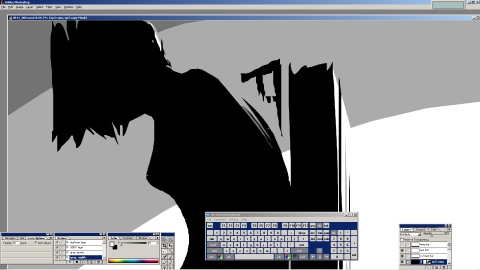
See if you can spot the little detail that I hadn't done yet!
By the way, you shouldn't work at 66.7% zoom in the ancient Photoshop 4 (and yet there's no way tell it to skip that zoom level when zooming, gar) 'cause it'll make your edges a little blurry. :P And it looks extra ugly. So obviously I wasn't really paying attention to what I was doing as I tried to get what I was hoping was the last little bit (it wasn't ;|) tweaked.
~~~~~~
(Warning: the video at the following link auto-plays and is kind of noisy at the beginning.)
Here's a neat BBC video of a prototype hybrid airship being developed by the British company Hybrid Air Vehicles Ltd, a 50-foot-long and propeller-driven craft filled with helium. That's 'cause it's only a little heavier than air, thanks to all the helium, so it needs just a tiny bit of additional lift from its rotors to stay airborne. It's supposed to be a very economical--if somewhat slow--method of air transport; no hybrid airship has ever made it past the prototype phase, but HAV Ltd has signed a £300 million deal with the US Army to develop the technology, so maybe this one will actually see the light of day; the full version is supposed to be 1000 feet long, able to stay aloft for three weeks without refueling(!), and capable of carrying 1000 tons through the air; at 1000 feet, it'd be 25% longer than the current record-holder for hugest air vehicle, the Hindenburg; they kind of stopped trying to make big airships after that line didn't end up so well in the 1930's, but part of the real problem they had back then was that helium was really expensive, and only available in the United States--and the US didn't have enough for its own airships, so there was a strict ban on exports--so the Hindenburg had to switch to all-too-flammable hydrogen.
So in a way (okay so this is a stretch; and incidentally, the cause of the ignition of the Hindenburg's hydrogen was never discovered), it's America's fault!

image by Gus Pasquerella (source)
36 lives lost--if only America had shared its helium with the Germans' top-of-the-line ship! Although, the Hindenburg was employed from time to time in dropping propaganda leaflets and flying over Olympic ceremonies for Hitler, so I suppose we can't be too broken up that the airship as a thing went away (I mean, the Hindenburg; the airship industry as a whole did cease to be after the accident, though).
Oh man! Just accidentally found the footage of the disaster on YouTube:
video on Youtube
That's the voice of American radio reporter Herbert Morrison who was on hand at Lakehurst Naval Air Station in New Jersey to report on the ship's first US/Europe round trip of the 1937 season. And I should have known this, but it is indeed his frantic use of the phrase in the commentary you can hear there that would make "oh the humanity" the satirical catchphrase we know and love today.
~~~~~
Oh yeah! My Sunday fairy tale comic, The Princess and the Giant, will of course be updating this weekend, so stop on by for that if you've got nothing better to do. And to catch you up, here's a teaser link (click the image :P) to last week's Princess page:

Have a long and happy weekend! I *think* I will be getting an A* update in for Monday (possibly not actually arriving until the wee hours of Tuesday morning, as has been my habit :P), after fireworks and all that. Be safe, don't end up like the Hindenburg!
|
·····
|
| |
| Excuses, excuses | Jul 01, 2011 10:44 AM PDT | url |
| | |
Added 1 new A* page:Edit/update: Waaaait! I do have pictures to save us from the sea of text: my various attempts at trying to shade today's page, from first to penultimate; *ultimately* I couldn't figure out how to make the thoroughly look interesting; all the heavy gray was killing the lines (I have *got* to stop abusing colons and semicolons in these articles :PP):



~~~~~
Bleh! So late with this one. Still have to do a "Friday" page, that'll be sometime in the wee hours of Saturday, naturally. :P I swear I'm gonna get this sleep schedule of mine straightened out some day...
Okay so a few days back on Twitter, an alert reader pointed out that Arthur C. Clarke, in his book 3001, had in item called the BrainCap, which let the wearer interface directly with a computer and boost their memory, or something (I'm partially getting that from Wikipedia, of course, since uh up until a couple days ago I hadn't even realized he'd continued the series past 2061 :o); anyway, the question was what do I think about that, considering all the explanation I was doing of how Selenis' neural implants might work (namely, as far as I can see they're sort of lesser implementations of what Clarke would have had in mind)?
Well, it seems to me that Clarke's idea was probably much better thought out and more likely to be the way things will/would actually go, once an interface like that was a possibility. But there are a number of reasons why Selenis, for instance, is not "jacked in" to quite that extent, I think--mind you this is me trying to figure out "why didn't I think of doing it that way" after the fact--so let me see if I can enumerate those.
First is what I suppose you could all the artistic reason, namely that personally I prefer a bit of a retro take on the whole outer space affair: a taste of the Space Race era--or what I've gathered about it in my haphazard way--with swooping rocket designs and an emphasis on a sort of steel girder, industrial look. I want to emphasize the rough and tumble, lawless, scrappy, rugged side of this society at the galactic core--after all, it's a very dangerous and somewhat disorganized place, and anyhow I want to have action adventure stories--so I'm focusing more on the physical aspects rather than networks and cyber-stuff and all that. Selenis does have computer enhancements, but they're more for enabling direct, physical activity than for sitting around crunching numbers or surfing the web. I suppose what it comes down to is that my brain isn't bursting with ideas of how to make cyberpunk work really well in an action comic, particularly a "hard science" one.
That's sort of a silly reason, so let's see if I can do a bit better with the second, which has to do with storytelling: this being a comic, and one that comes out one panel at a time, I want, maybe need, it to be direct and spare in its approach to getting through a story. For me this has meant dispensing with a disembodied narrator, and also resisting having characters narrate too much of their own actions; Vero did to a certain extent at times, but Selenis hardly ever does, as she's more of a veiled personality. That means if I want to have something said or described, it pretty much has to be as part of a dialogue--and so instead of plugging herself in to work some advanced mathematics, or collate past records on autonomous robot mining operations, she asks her computer program--"Mother"--to do it for her. This--I hope--makes for somewhat more interesting reading than lots of pages of characters sitting there with their eyes out of focus, calculating away. (And I didn't want to get into depicting them as digital avatars navigating cyber-space, either--well that gets back to the artistic reason, I suppose.)
Okay that storytelling thing was a pretty silly reason too, but this third one is slightly less so: the speed of light. Distances in A* are vast, and Selenis at, say, her secret moon base, is not close enough to some sort of vast network of users that she could access it and surf around, LPB-style; networking across the distances of light days, weeks, and even months from place to place in A* is more of a matter of writing a message, sending it, and waiting however long it takes for the response to arrive--or rather, going and doing something else with your time until the response arrives. So when she or the other characters are in these out-of-the-way places, there's really no opportunity for them to be cyber-jacking around much, anyway; they could use, I suppose, storage and processing power of their own computers, but not so much anything requiring exterior connections.
Well, that's about it!--my excuses for not taking computer interfacing to probably its logical conclusion, I mean, as better thinkers such as Clarke have. Eventually in A* we will probably get to a story taking place on something more like a populated planet, where connecting oneself to vast computer networks might be more the order of the day, but even if we do I probably wouldn't emphasize that too heavily as part of the main action...at least not unless I figure out a way to make it more exciting than *not* doing that. And I have had plans for a while now for a character who *is* rather heavily interfaced, you could say, but it will be taking the concept in a bit of a different direction.
Man! Not even a picture to break of the monotony of words this time; this article is everything I've just been declaring I want to avoid in A*! Doooh well I'll probably be able to steal some photos or movies or something for tomorrow's update.
|
·····
|
|
|
